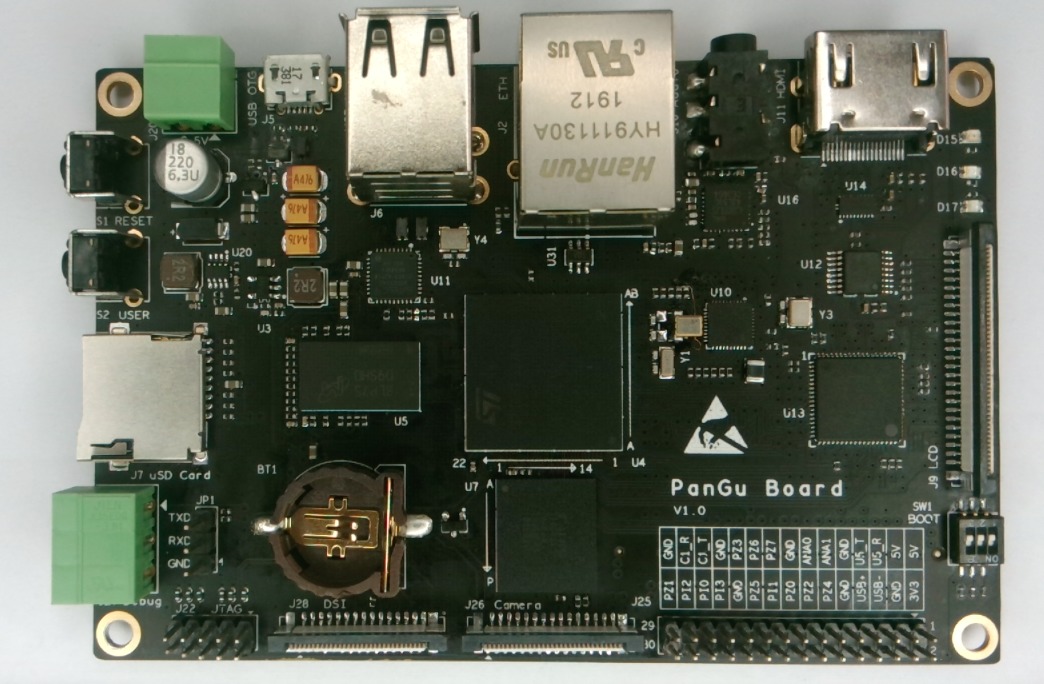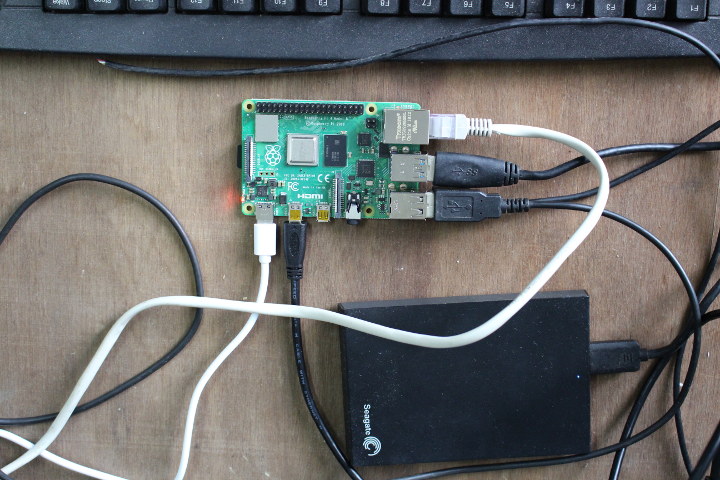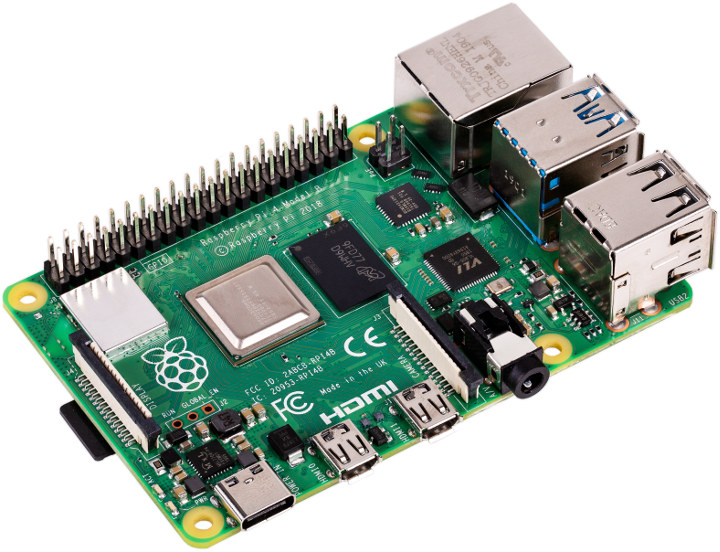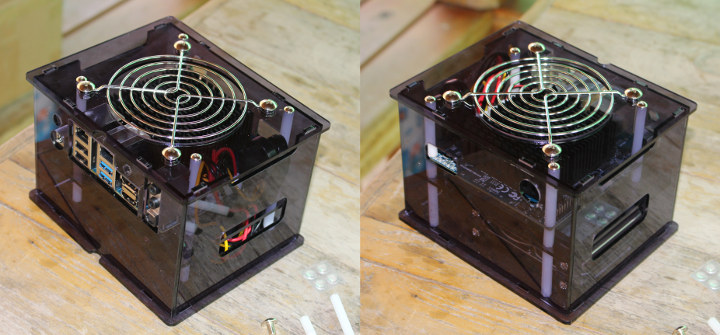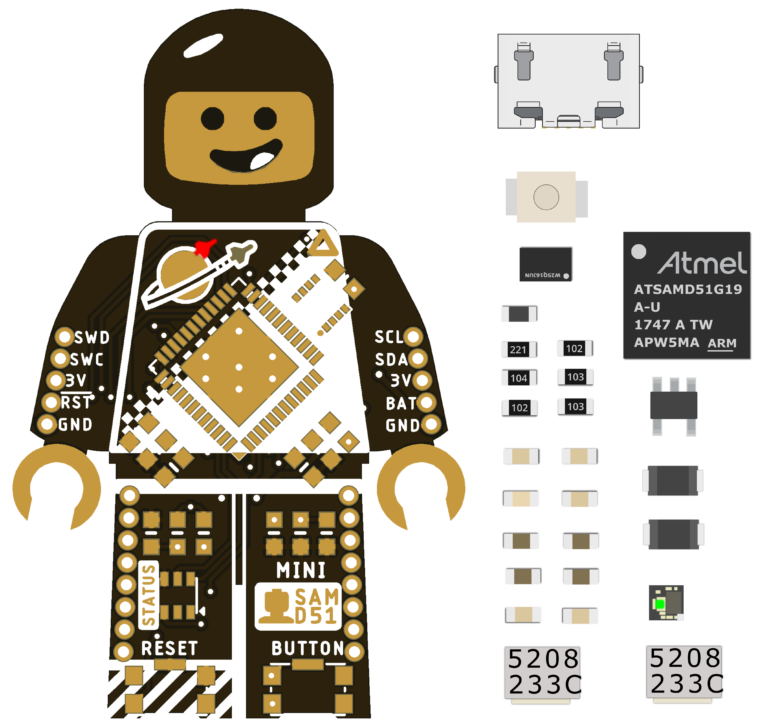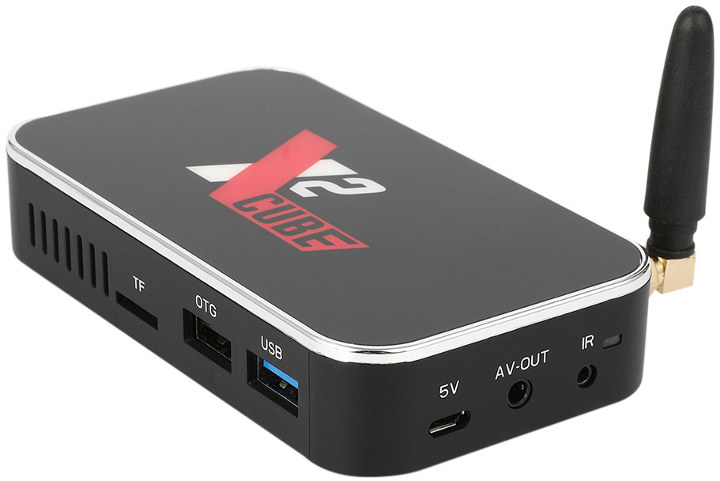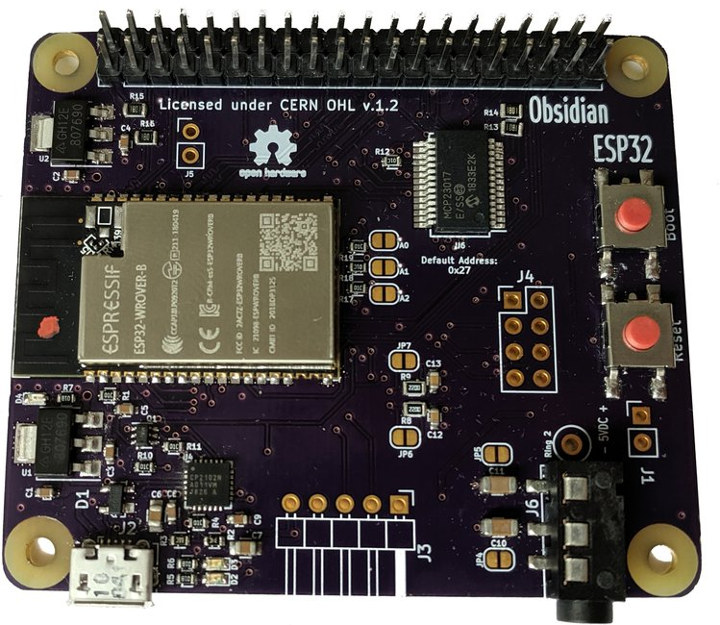The PanGu Board is a single board computer (SBC) that is feature-rich and versatile, at an affordable price point. The board powered by STMicroelectronics STM32MP1 processor was released in February of 2019 and hadn’t really made much a splash in the pool of microprocessors available at the time. The processor is now the main feature of the PanGu Board, an SBC with a host of features and utilizing the Arm dual-core Cortex–A7 MPU and the Cortex-M4 coprocessor to allow for more enhanced multimedia ability and all the heavy real-time processing that users are calling for today. Hardware Features MPU Dual Cortex-A7, 650MHz Cortex-M4, 209Mhz 3D GPU Flash & Memory 16-bit DDR3L, up to 1GByte 8-bit eMMC Flash Quad-SPI NOR Flash Supports Micro SD Audio 3.5mm stereo headphone jack support microphone input Display Parallel RGB LCD interface, the resolution up to WXGA (1366×768) MIPI DSI interface Support for resistive and capacitive […]
Raspberry Pi 4 Benchmarks & Mini Review
Raspberry Pi 4 has just been released with many improvements over Raspberry Pi 3 Model B+ including a faster processor, a proper Gigabit Ethernet port, USB 3.0 interfaces, and 4K video support. That’s the theory, but how does it work in practice? I can now let you know as I’ve received a Raspberry Pi 4 sample courtesy of Cytron, and ran some tests and benchmarks on the very latest boards from the Raspberry Pi foundation. System Info Before starting with the benchmarks, let’s go through some basic system info:
|
1 2 3 4 5 6 7 8 9 10 11 12 13 14 15 16 17 18 19 20 21 22 23 24 25 26 27 28 29 30 31 32 33 34 35 36 37 38 39 40 41 42 43 44 45 |
pi@raspberrypi:~ $ cat /etc/issue Raspbian GNU/Linux 10 \n \l pi@raspberrypi:~ $ uname -a Linux raspberrypi 4.19.46-v7l+ #866 SMP Fri Jun 7 18:00:39 BST 2019 armv7l GNU/Linux pi@raspberrypi:~ $ df -h Filesystem Size Used Avail Use% Mounted on /dev/root 13G 4.7G 7.4G 39% / devtmpfs 334M 0 334M 0% /dev tmpfs 463M 0 463M 0% /dev/shm tmpfs 463M 6.4M 456M 2% /run tmpfs 5.0M 4.0K 5.0M 1% /run/lock tmpfs 463M 0 463M 0% /sys/fs/cgroup /dev/mmcblk0p6 253M 40M 213M 16% /boot tmpfs 93M 0 93M 0% /run/user/1000 /dev/sda4 200G 175G 24G 89% /media/pi/USB3_BTRFS /dev/sda2 241G 181G 48G 80% /media/pi/USB3_EXT4 /dev/sda1 245G 182G 63G 75% /media/pi/USB3_NTFS pi@raspberrypi:~ $ cat /proc/cpuinfo processor : 0 model name : ARMv7 Processor rev 3 (v7l) BogoMIPS : 270.00 Features : half thumb fastmult vfp edsp neon vfpv3 tls vfpv4 idiva idivt vfpd32 lpae evtstrm crc32 CPU implementer : 0x41 CPU architecture: 7 CPU variant : 0x0 CPU part : 0xd08 CPU revision : 3 .... processor : 3 model name : ARMv7 Processor rev 3 (v7l) BogoMIPS : 270.00 Features : half thumb fastmult vfp edsp neon vfpv3 tls vfpv4 idiva idivt vfpd32 lpae evtstrm crc32 CPU implementer : 0x41 CPU architecture: 7 CPU variant : 0x0 CPU part : 0xd08 CPU revision : 3 Hardware : BCM2835 Revision : a03111 Serial : 00000000ea51204b |
|
1 2 3 4 5 6 7 8 9 10 11 12 13 14 15 16 17 18 19 20 21 22 23 24 25 26 27 28 29 30 31 32 33 34 35 36 37 38 39 40 41 |
$ inxi -Fc0 System: Host: raspberrypi Kernel: 4.19.46-v7l+ armv7l bits: 32 Console: tty 1 Distro: Raspbian GNU/Linux 10 (buster) Machine: Type: ARM Device System: Raspberry Pi 4 Model B Rev 1.1 details: BCM2835 rev: a03111 serial: 00000000ea51204b CPU: Topology: Quad Core model: ARMv7 v7l variant: cortex-a72 bits: 32 type: MCP Speed: 1500 MHz min/max: 600/1500 MHz Core speeds (MHz): 1: 1500 2: 1500 3: 1500 4: 1500 Graphics: Device-1: bcm2835-vc4 driver: vc4_drm v: N/A Device-2: bcm2835-hdmi driver: N/A Display: tty server: X.org 1.20.4 driver: modesetting unloaded: fbdev tty: 80x24 Message: Advanced graphics data unavailable in console. Try -G --display Audio: Device-1: bcm2835-audio driver: bcm2835_audio Device-2: bcm2835-hdmi driver: N/A Sound Server: ALSA v: k4.19.46-v7l+ Network: Message: No ARM data found for this feature. IF-ID-1: eth0 state: up speed: 1000 Mbps duplex: full mac: dc:a6:32:00:9e:9c IF-ID-2: wlan0 state: up mac: dc:a6:32:00:9e:9d Drives: Local Storage: total: 946.35 GiB used: 540.58 GiB (57.1%) ID-1: /dev/mmcblk0 vendor: SanDisk model: SL16G size: 14.84 GiB ID-2: /dev/sda type: USB vendor: Seagate model: Expansion size: 931.51 GiB Partition: ID-1: / size: 12.68 GiB used: 4.71 GiB (37.1%) fs: ext4 dev: /dev/mmcblk0p7 ID-2: /boot size: 252.0 MiB used: 39.3 MiB (15.6%) fs: vfat dev: /dev/mmcblk0p6 Sensors: Message: No sensors data was found. Is sensors configured? Info: Processes: 179 Uptime: 4h 37m Memory: 1000.5 MiB used: 324.1 MiB (32.4%) gpu: 76.0 MiB Init: systemd runlevel: 5 Shell: bash inxi: 3.0.32 |
For reference, you’ll find Raspberry Pi 4 Linux boot log here. Phoronix benchmarks Let’s go ahead and install the latest version of Phoronix benchmarks:
|
1 2 3 |
sudo apt install php-cli php-gd php-xml php-zip wget http://phoronix-test-suite.com/releases/repo/pts.debian/files/phoronix-test-suite_8.8.1_all.deb sudo dpkg -i phoronix-test-suite_8.8.1_all.deb |
Now let’s run the test to compare the performance of Raspberry Pi 4 model B to some other Arm Linux boards including Raspberry Pi 3 Model B.
|
1 |
phoronix-test-suite benchmark 1709271-TY-1704029RI26 |
For reference, my office has an […]
Raspberry Pi 4 vs Pi 3 – What are the differences?
So now that the Raspberry Pi 4 model B has just been launched, it may be worth checking out the differences against the previous latest single board computer from the Raspberry Pi foundation, namely Raspberry Pi 3 model B+. Let’s get straight to the Raspberry Pi 4 vs Pi 3 B+ comparison table. Features/Specs Raspberry Pi 4B Raspberry Pi 3 B+ Release date 24th June 2019 14th March 2018 SoC Broadcom BCM2711 quad-core Cortex-A72 @ 1.5 GHz Broadcom BCM2837B0 quad-core Cortex-A53 @ 1.4 GHz GPU VideoCore VI with OpenGL ES 1.1, 2.0, 3.0 VideoCore IV with OpenGL ES 1.1, 2.0 Video Decode H.265 4Kp60, H.264 1080p60 H.264 & MPEG-4 1080p30 Video Encode H.264 1080p30 Memory 1GB, 2GB, or 4GB LPDDR4 1GB LPDDR2 Storage microSD card Video & Audio Output 2x micro HDMI ports up to 4Kp60 3.5mm AV port (composite + audio) MIPI DSI connector 1x HDMI 1.4 port up […]
Raspberry Pi 4 Features Broadcom BCM2711 Processor, Up to 4GB RAM
Long expected, the Raspberry Pi 4 model B has finally launched, and it should not disappoint with a much more powerful Broadcom BCM2711 quad-core Cortex-A72 processor clocked at up to 1.5 GHz, 1 to 4GB LPDDR4, 4K H.265 video decoding and output support, a proper Gigabit Ethernet port, as well as USB 3.0 and 2.0 ports. Raspberry Pi 4 comes with all those extra features, but the form factor remains the same, and importantly the price is still $35 for the version with 1GB RAM, making Raspberry Pi alternatives suddenly much less interesting. Raspberry Pi 4 specifications: SoC – Broadcom BCM2711 quad-core Cortex-A72 (ARMv8) @ 1.5GHz with VideoCore VI GPU supporting OpenGL ES 3.0 graphics System Memory – 1GB, 2GB or 4GB LPDDR4 Storage – microSD card slot Video Output & Display I/F 2x micro HDMI ports up to 4Kp60 (Currently 1080p60 max. in dual-display configuration, although 2x 4Kp30 is […]
ODROID-H2 Rev B Review – Part 1: Kit Unboxing and Assembly
ODROID-H2 was announced in October 2018 as the first x86 SBC from Hardkernel. The board features an Intel Celeron J4105 Gemini Lake processor, two SO-DIMM slots for memory, two SATA ports and M.2 NVMe slot for storage, two Gigabit Ethernet ports, a mix of USB 3.0 and 2.0 ports, as well as HDMI and DisplayPort video outputs. The board went for sale the following month for $111, and the first batch of 2,000 boards was sold within 24 hours. In normal cases, this should not be a big problem, and in a few weeks, the company should have been able to produce more boards to fulfill the demand. But Intel decided to prioritize higher-end processors, and Gemini Lake SoCs’ manufacturing was put on the back foot. That means Hardkernel had to wait over 6 months to get supply of the Celeron J4150 processors. In the meantime, the company slightly redesign […]
LEGO Minifigure shaped Mini SAM M4 Board Supports CircuitPython and Arduino
If you are a fan of the Lego movie. Perhaps you have always wanted to use Lego bricks to make something innovative and techy. Then the Mini SAM M4 board is here for you, as it is a LEGO minifigure-sized development board. Additionally, the design and layout of the board is based around the classic 1980’s ‘spaceman’, and is made by Ben Shockley. Although the board is very small, it has a lot of wonderful features. It comes with an analog reference decoupling/filtering capacitors. Also, it has an analog to digital ferrite bead, as well as a debounce circuitry for the reset and user buttons. Furthermore, the board’s software and firmware can be developed using CircuitPython or Arduino. The development board is either based on the Microchip SAMD51G 48-Pin 32-Bit ARM – Cortex M4F MCU (Mini SAM M4), or features the Microchip SAMD21G 48-Pin 32-Bit ARM Cortex -M0+ MCU running […]
Ugoos X2 Cube Android 9.0 TV Box also Serves as a SAMBA Server
Ugoos X2 Cube is a tiny Android 9.0 TV box powered by the latest Amlogic S905X2 processor coupled with 2GB RAM and 16GB flash storage. The new Amlogic processor happens to have a USB 3.0 port which provides good storage performance, and the box is also equipped with a Gigabit Ethernet port, which should make the device especially suitable for network storage beside the usual 4K HDR video playback or streaming offered by any typical Amlogic S905X2 TV box. However in most cases, the firmware provided for such TV boxes does not offer an option to easily configure a SAMBA server (aka Windows network share), so you’d need to either mess up with the firmware configuration yourself, or install a paid app. Ugoos is different since they long have had the option to enable NFS & SAMBA client and/or server in the settings, and Ugoos X2 Cube is no different. […]
Obsidian ESP32 Board Follows Raspberry Pi Model A Form Factor (Crowdfunding)
When Thomas McKahan had been playing with ESP32 for a while, he found the need to use Raspberry Pi HAT boards and enclosure with his new hardware, so he went ahead and designed his own ESP32 board compatible with Raspberry Pi accessories, and following the smaller Raspberry Pi Model A / 3 Model A+ form factor. Obsidian ESP32 specifications: Wireless module – Espressif Systems ESP32-WROVER-B 802.11 b/g/n WiFi + Bluetooth 4.2 / BLE module with 16 MB flash, 8 MB PSRAM USB – 1x micro USB port for power and programming Audio – 3.5mm TRS audio jack connected to ESP32 DACs Expansion 40-pin GPIO header compatible with popular HAT expansion boards with 3.3 V signalling, I²S for audio DAC, I²C and SPI, Serial UART available on header or via microUSB, I²C GPIO expander with interrupts & address selection 8-pim unpopulated header from remaining I/Os accessible through GPIO expander 5-pin unpopulated […]

